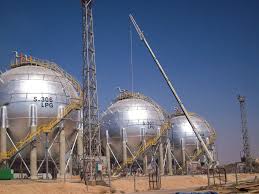Petroleum products stand as some of the most critical natural resources, abundantly available in our country. They serve as vital fuels in automobiles, generators, industrial plants, and cooking appliances, making them indispensable for daily individual, industrial, and national operations. The domestic liquefied petroleum gas (LPG) filling sub-sector within Nigeria's Oil & Gas Industry holds immense investment potential. A significant portion of the middle and upper socio-economic classes rely on gas for cooking, alongside industries, government entities, hotels, hospitals, restaurants, bakeries, and more.
Despite substantial gas reserves of 185 trillion cubic feet and the Nigerian government's robust commitment to gas industry development through the Gas Master Plan, the country's LPG consumption remains relatively low. Today, Nigeria consumes a significant amount of LPG annually, supported by numerous LPG plants and retailing outlets. Efforts to increase consumption would likely lead to a proportional increase in the number of LPG plants and retailing outlets.
The demand for LPG in Nigeria has surged, leading to scarcity and price fluctuations. Consequently, the distribution of gas products has been deregulated, opening opportunities for private individuals and firms to invest in the LPG value chain. This report outlines the step-by-step procedure for establishing an LPG Storage and Distribution filling station.
According to a World Bank report from 2010, over 50% of the global population directly or indirectly depends on hydrocarbon and petroleum products for survival. The proposed LPG storage and distribution facilities would have a substantial capacity, with a filling capacity suitable for meeting market demands. Financial considerations for the business include funding through a combination of equity and loans, with a focus on sustainable operational practices.
Overall, the thriving LPG market, combined with deregulation and government initiatives, presents a compelling investment opportunity in Nigeria's energy sector, specifically in LPG Bulk Storage and Distribution.
Despite substantial gas reserves of 185 trillion cubic feet and the Nigerian government's robust commitment to gas industry development through the Gas Master Plan, the country's LPG consumption remains relatively low. Today, Nigeria consumes a significant amount of LPG annually, supported by numerous LPG plants and retailing outlets. Efforts to increase consumption would likely lead to a proportional increase in the number of LPG plants and retailing outlets.
The demand for LPG in Nigeria has surged, leading to scarcity and price fluctuations. Consequently, the distribution of gas products has been deregulated, opening opportunities for private individuals and firms to invest in the LPG value chain. This report outlines the step-by-step procedure for establishing an LPG Storage and Distribution filling station.
According to a World Bank report from 2010, over 50% of the global population directly or indirectly depends on hydrocarbon and petroleum products for survival. The proposed LPG storage and distribution facilities would have a substantial capacity, with a filling capacity suitable for meeting market demands. Financial considerations for the business include funding through a combination of equity and loans, with a focus on sustainable operational practices.
Overall, the thriving LPG market, combined with deregulation and government initiatives, presents a compelling investment opportunity in Nigeria's energy sector, specifically in LPG Bulk Storage and Distribution.
1.0 Project profile
1.1 Opportunity rationale
1.2 Project Brief
1.3 Market entry time
1.4 Legal Status
1.5 Proposed storage capacity
1.6 Proposed cost
1.7 Break- Down of capital cost
1.8 Break – Down of working capital
1.9 Recommended project parameter
1.10 Proposed location
1.11 Site Feasibility
2.0 Key Success Factors
3.0 Sector and Industry Analysis
3.1 Sector characteristic & Overview
3.2 Sources of LPG in Nigeria
4.0 Market
4.1 Local production of LPG
4.2 LPG producers in Nigeria
4.3 Production process of LPG
4.4 Market Information
4.5 LPG Value chain
4.6 LPG Bulk Storage facility in Nigeria
4.7 Market Demand
4.8 Nigeria current status ( Supply & Pricing)
4.9 LPG Consumption in Nigeria
4.10 SWOT Analysis
5.0 Product /Project standard and compliance issues
5.1 Pre-qualification of LPG License
5.2 REGULATIONS AND CONDITIONS GOVERNING THE CONSTRUCTION OF LIQUEFIED PETROLEUM GAS (LPG) BULK STORAGE PLANT.
5.3 STORAGE TANKS DESIGN SPECIFICATIONS AND FITTINGS
5.4 TANK LOCATION AND SAFETY DISTANCES
5.5 Pre -License Inspection
6.0 Management Feasibility
6.1 Tank Farm manpower requirement
6.2 Key responsibility of personnel
7.0 Technical Feasibility
7.1 Project design consideration
7.2 Mechanical component and estimated cost
8.0 Risk & Risk Mitigation
9.0 Financial Plan
9.1 Project Cost
9.2 Project Financing
9.3 Key variable
9.4 Revenue assumptions
9.5 Expense assumptions
9.6 Other assumptions
9.7 Projected income statement
9.8 Projected Cash –flow
9.9 Repayment Schedule
1.1 Opportunity rationale
1.2 Project Brief
1.3 Market entry time
1.4 Legal Status
1.5 Proposed storage capacity
1.6 Proposed cost
1.7 Break- Down of capital cost
1.8 Break – Down of working capital
1.9 Recommended project parameter
1.10 Proposed location
1.11 Site Feasibility
2.0 Key Success Factors
3.0 Sector and Industry Analysis
3.1 Sector characteristic & Overview
3.2 Sources of LPG in Nigeria
4.0 Market
4.1 Local production of LPG
4.2 LPG producers in Nigeria
4.3 Production process of LPG
4.4 Market Information
4.5 LPG Value chain
4.6 LPG Bulk Storage facility in Nigeria
4.7 Market Demand
4.8 Nigeria current status ( Supply & Pricing)
4.9 LPG Consumption in Nigeria
4.10 SWOT Analysis
5.0 Product /Project standard and compliance issues
5.1 Pre-qualification of LPG License
5.2 REGULATIONS AND CONDITIONS GOVERNING THE CONSTRUCTION OF LIQUEFIED PETROLEUM GAS (LPG) BULK STORAGE PLANT.
5.3 STORAGE TANKS DESIGN SPECIFICATIONS AND FITTINGS
5.4 TANK LOCATION AND SAFETY DISTANCES
5.5 Pre -License Inspection
6.0 Management Feasibility
6.1 Tank Farm manpower requirement
6.2 Key responsibility of personnel
7.0 Technical Feasibility
7.1 Project design consideration
7.2 Mechanical component and estimated cost
8.0 Risk & Risk Mitigation
9.0 Financial Plan
9.1 Project Cost
9.2 Project Financing
9.3 Key variable
9.4 Revenue assumptions
9.5 Expense assumptions
9.6 Other assumptions
9.7 Projected income statement
9.8 Projected Cash –flow
9.9 Repayment Schedule
$220 (N300,000)
Get your conditional loan offer: admin@fundxperts.com
Contact: admin@fundxperts.com

